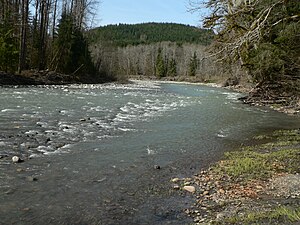geo.wikisort.org - River
The Stillaguamish River is a river in the northwestern region of the U.S. state of Washington. It is mainly composed of two forks, the longer North Fork Stillaguamish (45 miles (72 km)) and the South Fork Stillaguamish. The two forks join near Arlington. From there the Stillaguamish River proper flows for 22 miles (35 km) to Puget Sound. The river's watershed drains part of the Cascade Range north of Seattle.
| Stillaguamish River | |
|---|---|
 The South Fork of the Stillaguamish River near Verlot | |
| Location | |
| Country | United States |
| State | Washington |
| Physical characteristics | |
| Source | North Cascades |
| • coordinates | 48°12′14″N 122°7′38″W[1] |
| Mouth | Puget Sound |
• location | Port Susan |
• coordinates | 48°14′18″N 122°22′38″W[1] |
• elevation | 0 m (0 ft) |
| Length | 67 mi (108 km)[2] |
| Basin size | 700 sq mi (1,800 km2) |
Course

The Stillaguamish River is formed from the confluence of the North and South Forks, both of which rise in the Cascades. Between the North and South forks there is a portion of the Mount Baker-Snoqualmie National Forest called the Boulder River Wilderness.
The North Fork rises as several branches in a remote area of Skagit County near Finney Peak, approximately 10 miles (16 km) north of Darrington. Collecting many tributary creeks, the river flows south, then west through the foothills along the Skagit-Snohomish county line. Tributaries of the North Fork Stillaguamish River include Boulder River and Deer Creek.
The South Fork (30 miles (48 km)) originates from the northern slopes of Del Campo Peak and Morning Star Peak in central Snohomish County, 20 miles (32 km) south of Darrington, and flows west and northwest by Silverton, Verlot, and Granite Falls.
The two forks unite at Arlington in northwestern Snohomish County. The combined stream flows west before it briefly splits again to encircle the town of Silvana.
The Stillaguamish bifurcates at its delta to form Florence Island before entering Puget Sound.[3] Hatt Slough flows southwest and is now the primary distributary of the Stillaguamish waters into Port Susan, having been diverted in the early twentieth century. The Old Stillaguamish River Channel flows northwest towards Florence and then Stanwood on an 8 mile meandering course. Near the Camano Island bridge this channel again splits, forming Leque Island, with the South Pass flowing into Port Susan and the West Pass emptying into the southern end of Skagit Bay.[4]
Natural history
The Stillaguamish River and its tributaries are known for their salmon runs. Eight salmonid species use the streams for spawning, including Chinook, coho, chum, pink, and sockeye salmon, steelhead trout, sea-run cutthroat, and bull trout.
Hydrology
The north fork of the Stillaguamish river level is monitored by gauges operated by the United States Geological Survey (USGS),[5] and river levels can vary by as much as 13 feet (4.0 m). The river level rises and falls very quickly, with the average north fork flood duration of eight hours. Of the five highest north fork flood levels on record, three have occurred since 2009.[6]
History
Variant names for the Stillaguamish River, according to the USGS, include Tuxpam River, Stoh-luk-whahmpsh River, Stillaquamish River, Steilaguamish River, Stalukahamish River, and other similar spellings.
The 2014 Oso landslide occurred on the North Fork of the Stillaguamish.
See also
- List of Washington rivers
References
- U.S. Geological Survey Geographic Names Information System: Stillaguamish River
- Including North Fork
-
"Snohomish County – Florence". An Illustrated History of Skagit and Snohomish Counties. Interstate Publishing Company. 1906. p. 368.
Similar to Stanwood in its general surroundings and in the nature of the occupations to which it is open is the village of Florence. This pleasant little place is located upon the south bank of the Stillaguamish river three and a half miles by boat and two miles by road east of Stanwood. It is located upon what may be called the delta of the river created by the sediment brought down through ages by that stream and by the spreading channels with which it enters the waters of the sound. A few miles above Florence the main river divides and a channel known as Hat slough leaves it toward the South. A little below Florence the river is again divided, what is known as South slough parting from it. Thus between the main river and the two sloughs and the waters of the sound lies a beautiful and fertile island. This is known as Florence island. The town of Florence is at the head of regular steamboat navigation on the Stillaguamish river.
- Coffler, Sarah; Joy, Joe (October 2005). Old Stillaguamish River Channel Diel Surveys (PDF) (Report). Washington State Department of Ecology. Retrieved March 23, 2022.
The Old Stillaguamish River Channel is a vestigial channel connecting the mainstem of the Stillaguamish River to Port Susan and Skagit Bay (Figure 1). The channel was left as a secondary outlet after the main portion of the Stillaguamish River was diverted to Port Susan via Hatt Slough over 70 years ago. The Old Channel meanders for eight miles until it bifurcates at about river mile (RM) 1.5; South Pass transports about 80% of the flow to and from Port Susan; and West Pass carries the remaining flow to and from Skagit Bay.
- "National Weather Service Advanced Hydrologic Prediction Service". water.weather.gov. Retrieved Jun 21, 2020.
- "Historical Crests for North Fork Stillaguamish River near Arlington". water.weather.gov. Retrieved Jun 21, 2020.
External links
На других языках
[de] Stillaguamish River
Der Stillaguamish River ist ein Fluss im Nordwesten des US-Bundesstaates Washington.- [en] Stillaguamish River
Другой контент может иметь иную лицензию. Перед использованием материалов сайта WikiSort.org внимательно изучите правила лицензирования конкретных элементов наполнения сайта.
WikiSort.org - проект по пересортировке и дополнению контента Википедии

